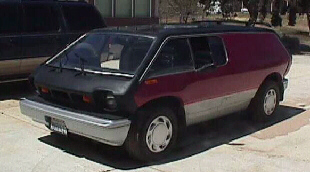|
|
||
|
||
| Zitat: Dune Buggies & Hot VWs, Sommer 1972 | ||
|
By Chuck Nerpel
It could put the FUN in functional! Every once in a while a bright
and talented automotive stylist with the mechanical talent and
Originally conceived as a kit car, something for the homebuilder to build up in his spare time on a VW Beetle chassis, market research revealed that there were a lot more customers out there interested in a complete vehicle than a do-it-yourself kit. This is a major undertaking for any private car builder, considering the Federal safety requirements, plus the need to start with a complete VW running gear, belly pan, and power plant. Volkswagen does not supply bodyless cars to anyone, and the source of supply for a builder like Brubaker is to buy complete cars from any new car outlet he can, strip off the body and hope to become a good source of supply for specialty repair shops that might need such parts. Besides, the Brubaker mini-van
is a great deal more than a fabricated box bolted to a VW belly pan. Safety
is a major part of the design and construction, with the body unit itself
composed of inner and outer fiberglass panels, riveted and adhesive bonded
together and to a floor pan whose edges are rolled up and similarly bonded
to the upper assembly. The result is a very rigid body that has built-in
roll-over protection, and when bolted to the VW pan, stiffens it as well.
To protect the shell and the sub frame from damage of low speed bumper-to-bumper
Another safety feature, one that adds to the rigidity of the body or passenger envelope, is the single door, a rather ample one on the right side that slides rather than swings open. This design follows the latest thinking of some "safety car" engineers as a way to better protect passengers by eliminating weak areas around the door openings and the number of those openings. While there has been some thought given to the addition of a door on the driver's side to ease entry and exit, current plans are for production of only the single side door model. This door slides in a groove along the roof line edge with a bell jointed stabilizer rod at the bottom to keep it aligned when operated. While the driver might inconvenience the front passenger, the door opens wide enough for easy walk-in to the rear seating area. This doesn't mean stand-up walk-in as the Brubaker is quite a bit smaller than the familiar VW van bus. In fact, dimensions are closer to that of the Beetle sedan, with the height an inch lower, length and inch less, but eight inches wider, providing a bit more elbow room than the sedan The idea behind the Brubaker was not to try and make a big van out of a Beetle sedan, but to create a passenger type utility vehicle with good utilization of interior space on a relatively short wheelbase. Top this off with the known fuel economy of the VW engine, lower center of gravity for better handling, styling to reduce the slab-sided look of a big van, plus a better shape for lower wind resistance and better cross-wind stability. Couple all of this with an overall look that is most distinctive, a very desirable feature in today's automotive look-alike offerings. While the Brubaker body can
be bolted directly to a Beetle Type I sedan belly pan, other
Experiments are still going
on as to just what type of front seats will be used. Because of the
Obviously, passenger vehicles
should have more than just distinctive looks. That is all many
Inside, the ride is quiet
and comfortable with the double wall construction screening out
There are some minor changes being made to the pedal position to provide better access to them without kneeing the low set steering wheel in the process. As mentioned earlier, forward and side visibility for the driver is good but the seating position well back poses some problems with overhead vision such as a high set traffic signal. The driver will also have to make good use of well set mirrors on both sides, as the view to the rear sides is virtually non-existent. Current plans are to also offer a sun roof version with accessories to include possibly a roof rack and provision for carrying surf boards and maybe even a small boat. It is difficult to provide
an accurate report on a vehicle when the available prototypes are in
To be sold as complete vehicles, the mini-vans must meet all federal standards for safety and exhaust emission control, the latter already established by Volkswagen for their engines and running gear. The other safety features must be approved by actual tests and certified by an accredited testing organization. This is now being done. Tentative prices, FOB, Brubaker
Industries, Inc., 5625 West Century Blvd., Los Angeles, Calif., 90045,
are between $3600 and $4000, and includes a new VW chassis, deluxe interior,
alloy wheels, and wood rimmed steering wheel. Launching such a project
by an individual, who is not a multi-millionaire or the heir to an auto-maker's
fortune, is a tremendous undertaking.
|
||
|
|
||
|
Zurück zur Brubaker-Hauptseite Zum Teil 3 Seitenanfang Kontakt Volkswagen und VW sind eingetragene
Warenzeichen der Volkswagen AG. Geschützte Produkt- oder Firmennamen
werden zu rein nichtkommerziellen Zwecken zitiert.
|
